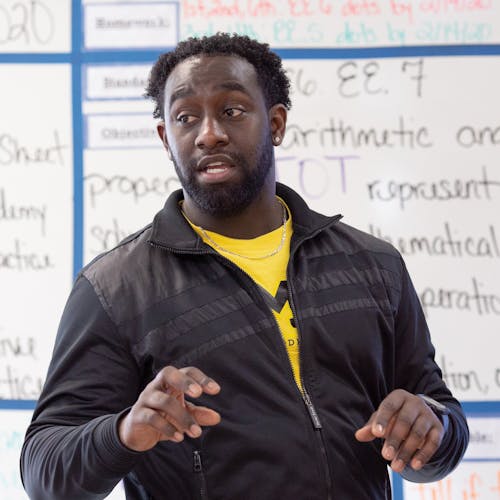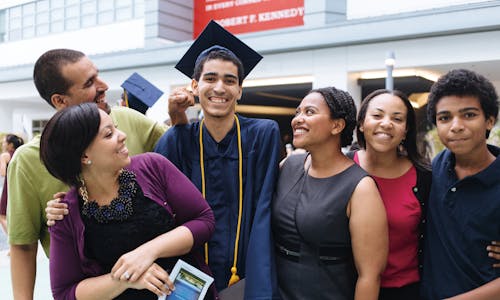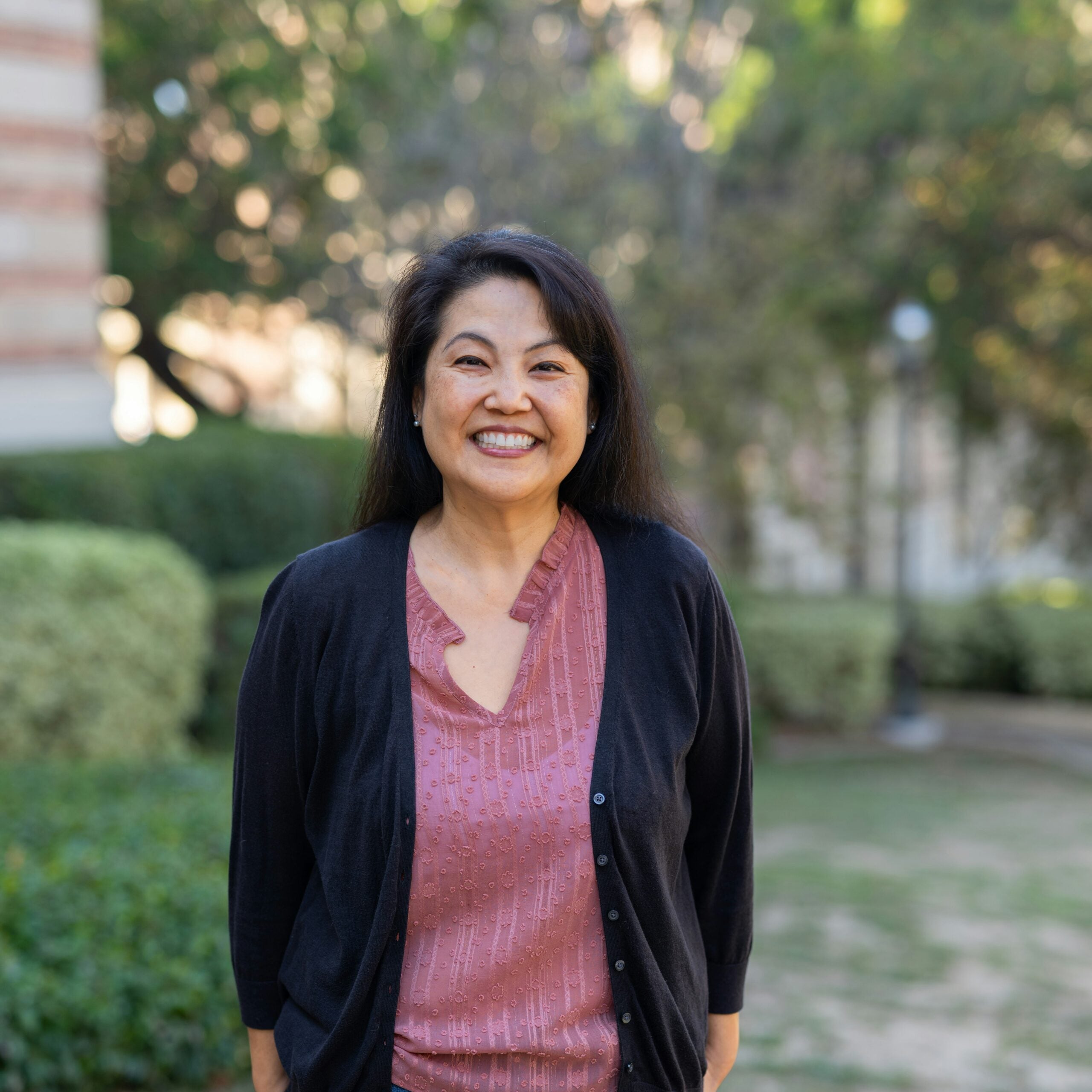An in-depth look at the importance and long-term impacts of university-assisted schools on the first-generation college student population, one of the most high-risk populations for college non-persistence, excerpt from the dissertation by Sarah Bang, Ed.D., ’20, executive director, UCLA California Institute on Law, Neuroscience & Education.
Sarah Bang (’99, B.A., Sociology; ’09, M.A., Teacher Education Program; Ed.D. Education, ‘20) was a founding staff member of UCLA Community School, UCLA’s first University-assisted school, where she helped to grow a revolutionary pilot school into a hallmark K-12.
Bang says that the early days of creating a research-based pilot school – known for increasing the college-going rate in the Koreatown-Pico-Union area – was “the scariest, best time in all of our lives.”
“It was like we were doing something really amazing, but we didn’t always know what we were doing,” she laughs. “The thing that makes the school amazing is its pilot school autonomy… and individualized things that made us unique like finding our own curriculum or having different ways of assessing.
“For me, it was being part of a community, not just with the teachers and students, but with the families, and feeling like a part of something groundbreaking,” notes Bang. “Something bigger than me, bigger than all of us, and being able to do it with people who were not just my colleagues, but my friends. That’s like a dream come true – you don’t get that in most jobs.”
Bang also created UCLA Squared, a support system for UCLA Community School alumni who now attend UCLA. Most recently, Bang was the director of the TIE-INS (Together in Education in Neighboring Schools) Program and is now Executive Director, UCLA California Institute on Law, Neuroscience & Education housed at UCLA School of Education and Information Studies.
DISSERTATION EXCERPT
The first-generation student population continues to grow and yet they are still one of the most high-risk populations for college non-persistence. A promising intervention with research-based potential for combating first-generation drop-out rates in college is university-assisted schools. This study examines what first-generation students who attended a university-assisted high school say helped them persist through college. It also investigates potential ways that university-assisted high schools can better support first-generation students to persist in college. Utilizing a qualitative research design, participants were interviewed and their perceptions of experiences were coded and analyzed. This study’s findings point to first-generation students from a university-assisted school creating and relying on networks to persist in college. These networks filled areas that first-generation students generally tend to lack: a sense of belonging and social and cultural capital. This study also found that the traditional “deficit” model used to support first-generation students’ needs reframing and rethinking to change the way high schools and institutes of higher education approach supports for first-generation students.
WHAT HAS BEEN SHOWN TO WORK
Approachable and supportive faculty. Means & Pyne’s (2017) study established that relationships with faculty were found to be pivotal for minority first-generation college students’ development of self-efficacy and sense of belonging. In a more extensive study of student-faculty relationships, Morales (2014) conducted research on 50 academically resilient, low socioeconomic status students of color. His findings centered around what professors and faculty did that resulted in development of self-efficacy for first-generation students. Faculty who were highly attuned to the specific needs of first-generation students, and modified their practices to better educate them, proved to be invaluable to the success of students.

In another study that investigated sense of belonging for students, Freeman et al. (2007) provided evidence that first-generation students attributed faculty members’ friendliness, helpfulness, and their ability to encourage participation in class to their own sense of belonging. Longwell-Grice (2016) found that first-generation students found the ability to work through issues with mentors critical to their successful navigation of college. Specific interventions that faculty and staff can employ, including how to make themselves approachable, came out of these studies (Ishitani, 2006; Morales, 2014; Strayhorn 2012).
Being available before and after class, making students feel that they matter, and encouraging them to participate in class are all ways that faculty can contribute to first-generation students’ sense of belonging (Ishitani, 2006). Building relationship with them contributes to social and academic capital for first-generation students while also attending to students’ social integration needs (Strayhorn, 2012). This is especially relevant because of acculturation issues first-generation students face between home and school. Students are more motivated when they feel cared for (Longwell-Grice et al., 2016) and findings suggest that the number of advisor-advisee meeting may positively affect first-generation student persistence (Ishitani, 2006).
Faculty of color. Even more effective in helping students of color are faculty of color, who can serve as a significant source of support. Several researchers have found Latino faculty members have a positive impact on Latino student success (Cedja & Rodes, 2004; Hagedorn et al., 2007; Perez et al., 2006). Studies have also shown that Hispanic faculty and other faculty of color are more likely than White faculty to offer emotional support, foster student success 22 through encouragement, and raise aspirations for students of color (Laden, 1999; Landen & Hagedorn, 2000; Turner & Myers, 2000). However, according to the National Center for Education Statistics (2016), of the 1.5 million faculty in degree-granting postsecondary institutes, only 5% were Hispanic, 6% were Black, and 10% were Asian/Pacific Islander. Colleges and universities face pressure to provide access to diverse student populations, yet they are finding it difficult to retain first-generation students of color. These students face greater challenges than their continuing-generation and non-minority counterparts and are at high risk for dropping out because they are more often from low socioeconomic status backgrounds, lack family support, academic preparation, and knowledge about higher education. Acculturation issues, cultural and academic conflict also compound drop-out rates for first-generation students.
University-Assisted Schools The intervention that shows unique promise for smoothing transitions to post-secondary education for first-generation students is university-assisted schools. With the wealth of resources, research, and expertise that universities can provide, these partnerships show great promise in helping schools serve first-generation students. Colleges and universities are increasingly using resources to develop partnership schools, with over 20 university partnerships in the University-Assisted Community Schools Network alone. In Los Angeles, UCLA has an initiative called the Center for Community Schooling to advance university-assisted community schools like the UCLA Community School in Koreatown and the Mann UCLA Community School located in South Los Angeles. The university’s resources are used to position K-12 schooling as a public good and prepare more students for college and careers.
The university-assisted community school approach was first developed by the University of Pennsylvania in 1985 with both school and community partners in West 23 Philadelphia. The design for these schools was based on John Dewey’s theory that the community school can function as the major hub for neighborhoods by providing comprehensive services, spurring other community groups, and helping with issues that communities face. Since schools belong to the community, they serve as an ideal center for community engagement (Harkavy et al., 2013). Universities are uniquely positioned to provide support for community schools in the areas of academic and instructional support, health and human services, college access programs, research, and evaluation (Harkavy et al., 2013). Quartz et al. (2017) maintain that universities also provide potential for bringing together research and practice to bring about real change in schools, and potentially beyond, with the promise of innovation to districts. Eventually, university-assisted schools were deliberately designed to disrupt persistent patterns of inequality and to prepare low-income students, students of color, and first-generation students to succeed in college (Quartz et al., 2017). The concept has since been adapted nationally.

Such schools have had success in graduating marginalized and first-generation students. For instance, the UCLA Community School in Koreatown reports a nearly 100% high school graduation rate and postsecondary plan rate over 90%. A recent report by Jacobo & Quartz (2019) shows that the UCLA Community School alumni persist at a higher rate in college compared to the nation and state of California. Another successful example of a university-assisted school is the Richmond Aspire California College Preparatory Academy (CAL Prep). CAL Prep is a public charter school that was co-founded by the University of California, Berkeley and Aspire Public Schools in August 2005. The mission of the school is to help underserved low-income and first-generation students gain access to college and to succeed in institutes of higher education. The school serves approximately 420 students in grades 6-12, with 80% of the students from racial and ethnic groups under-represented in higher education. The 24 student body is 19% African American, 60% Latino/Hispanic, 2.3% Asian, 3% Filipino, 2% East Indian, 2.4% Multi-ethnic/Caucasian, and 11.7% Other; 10% are English Language Learners, 68% are eligible for free or reduced lunch, and 72% will be first in their families to graduate from college. According to their website, the school boasts an impressive 100% college acceptance rate for all its graduates with each graduating class being around 60 students each year (Center for Educational Partnerships, 2020).
A third example of university-assisted school in California is the Preuss School, a collaboration with the University of California, San Diego that opened in 1999. The school began when a group of UC San Diego faculty began planning for ways to increase the number of low-income and under-represented groups at UC San Diego. Built and run by the university in partnership with the San Diego Unified School District, the Preuss School has become a unique middle and high school serving low-income students who strive to be the first in their families to go to college. Education Data Partnership (2019) reports the student population is almost 60% Hispanic or Latino, nearly 15% Asian and 10% African American. Students are selected through a lottery application process and must meet two eligibility requirements: Be from a low-income family and have no parent or guardian who has graduated from a four-year college. According to their website, 90% of their graduates are consistently accepted to four-year colleges and universities and nearly 100% of their graduates go on to some form of higher education (2020).
To read the full paper, visit: https://escholarship.org/uc/item/4mx0n603
